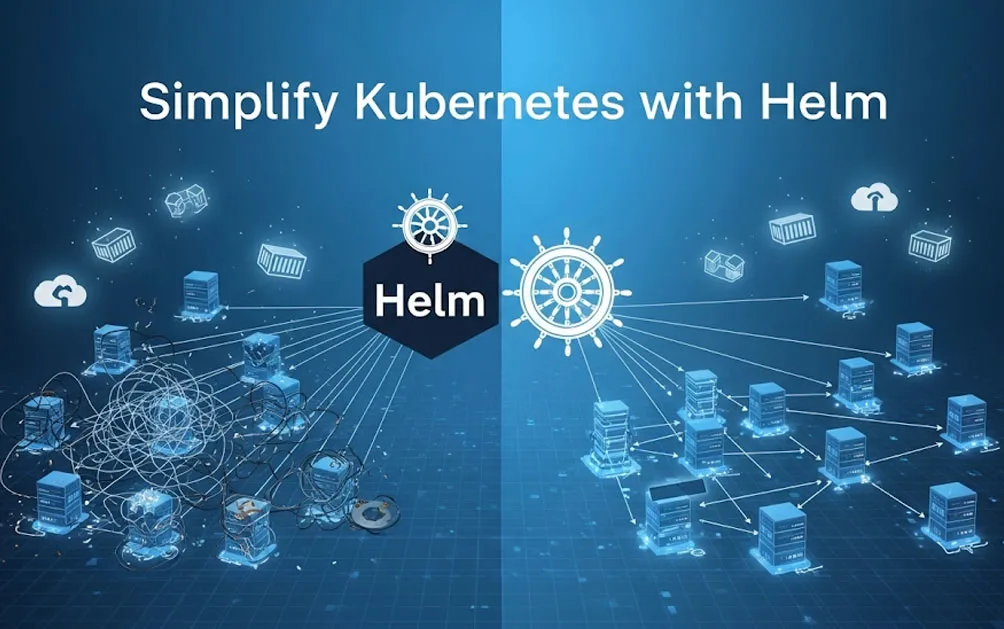Helm Makes Kubernetes Actually Manageable
Kubernetes is powerful. No doubt about that. But if you’ve spent more than a few days managing clusters, you know it can also be… exhausting. YAML files everywhere, configs that mysteriously break, services that don’t talk to each other. It’s kind of like trying to assemble IKEA furniture in the dark.
That’s where Helm comes in. It’s not a magic fix, but it’s the tool that makes all the difference. Think of it as a package manager for Kubernetes like apt or yum on Linux. Instead of juggling dozens of files for every app, Helm bundles everything together into one package called a chart. Install, upgrade, rollback — all with a few commands.
Honestly, once you start using it, going back to raw YAML feels like punishment.
Why Helm Feels Different in Kubernetes
Imagine installing software without a package manager. You’d spend hours fetching dependencies, editing configs, and hoping nothing conflicts. Kubernetes without Helm is basically the same thing.
Each deployment requires services, secrets, ingress, config maps — and they all need to fit together perfectly. Forget one detail and the app won’t start. Helm bundles all that into a single chart. You set some variables, tell it to install, and it handles the rest. Dependencies, secrets, configs — taken care of.
It’s not flashy, but it’s effective.
Breaking Down the Pieces of Helm
Helm might look complicated at first, but it’s mostly four things:
- Charts – Think of them as blueprints. They include everything the app needs to run.
- Values – A values.yaml file holds settings for different environments. Change one value, and the app adapts.
- Repositories – Public stores like Bitnami or Artifact Hub host tons of ready-to-use charts.
- Releases – Every installation gets a release name. Makes it easy to manage multiple instances.
Once you grasp these, Helm stops feeling like a separate tool and starts feeling like part of Kubernetes itself.
Helm vs kubectl
I get it, kubectl is the classic choice. Apply your manifests, watch things run, repeat. But in practice, it gets messy fast. Multiple YAML files, manual updates, making sure staging matches production — it’s tedious.
Helm builds on top of kubectl and wraps all the chaos into something manageable. Here’s how it compares:
| Feature | Helm | kubectl |
|---|---|---|
| Deployment | One command handles everything | Multiple YAML files |
| Upgrades | Clean, reversible | Manual, prone to errors |
| Template management | Parameterized charts | Static YAMLs |
| Reusability | Across environments | Each deployment is new |
It is not that kubectl is bad. It is just that Helm saves hours, keeps things consistent, and reduces those ‘why is staging broken again?’ moments.
Getting Started With Helm
Installing Helm is straightforward. It lives on your machine, not on the cluster, so you don’t need to install anything in Kubernetes itself.
Mac: brew install helm
Ubuntu: apt install helm
Then it hooks into your kubeconfig automatically. No extra setup. No plugins. Once installed, you can add repositories, search for charts, and deploy apps almost immediately.
Installing Apps in Minutes With Helm
Say you want Prometheus or Nginx running. Normally, that would be a multi-file, multi-step ordeal. With Helm, it’s simple:
- Add the repo (Bitnami, for example).
- Search for the chart.
- Run
helm install <release-name> <repo>/<chart>.
Within moments, your app is up. Dependencies resolved, configs applied, secrets handled. It’s fast, reliable, and you start wondering why you ever did it manually.
Why kubectl Isn’t Enough for Kubernetes
Some engineers stick with kubectl because it feels pure. And sure, for tiny apps or test clusters, it works fine. But once you scale, you realize how fragile manual YAML management is.
Helm doesn’t take away control — it just organizes it. Instead of editing ten files every time, you tweak one value, run a command, and everything updates. Less headache, more consistency.
Building Your Own Helm Charts
Helm is not just about using pre-made charts. You can create your own with helm create <chart-name>. It gives you the folder structure and templates. You just drop in your Docker image and tweak the variables.
For teams running multiple services, this is a lifesaver. You get a reusable, versioned package that works in dev, staging, and production without constant copy-pasting.
What Using Helm Feels Like
Daily operations with Helm are… quiet. You upgrade a service, roll back another, uninstall one completely — all without hunting through dozens of YAML files. The cluster stays consistent, teams stay aligned, and small mistakes don’t blow up production.
It doesn’t remove Kubernetes’ complexity entirely, but it makes the day-to-day manageable. You spend less time fighting configs and more time actually shipping features.
Wrapping It Up: Helm for Kubernetes
Helm doesn’t make Kubernetes magically simple. Nothing does. But it makes it reliable, predictable, and far less painful. Charts, values, releases — these are the tools that let engineers manage clusters without losing their minds.
Define your chart, adjust your values, and let Helm do the heavy lifting. Kubernetes will still be Kubernetes, but with Helm, it finally feels… manageable.





